Processing of - MTU Aero Engines
Processing of - MTU Aero Engines
Processing of - MTU Aero Engines
You also want an ePaper? Increase the reach of your titles
YUMPU automatically turns print PDFs into web optimized ePapers that Google loves.
<strong>Aero</strong>mat Presentation Jun 9, 2009<br />
<strong>Processing</strong> <strong>of</strong> (α/β) and (α2/γ) Titanium Alloys to<br />
Tailor Microstructure for Performance<br />
Gerhard Welsch<br />
J. Hausmann. K, Baumann, S. Lenser, K. Kelm, L. Chernova; K. Weber; S. Reh<br />
W. Smarsly<br />
Case Western Reserve University<br />
Deutsches Zentrum für Luft- und Raumfahrt<br />
<strong>MTU</strong> <strong>Aero</strong> <strong>Engines</strong><br />
Objective<br />
1. Develop unique titanium alloys<br />
composition<br />
microstructure(s)<br />
properties for high performance applications<br />
2. Exceed properties <strong>of</strong> standard (mill-processed) alloys<br />
in cast or wrought (plate, sheet, rod, wire) products<br />
3. Cost-effectiveness<br />
Material selection<br />
Primary and secondary processing methods<br />
Reproducibility<br />
Reliability
Rationale for this study:<br />
Ti-6w%Al-4w%V, or in atom percent Ti-10.5Al-3.5V, is the most widely used and<br />
perhaps best investigated high-strength, two-phase (α+β) solid-solution titanium<br />
alloy. It represents the vast majority <strong>of</strong> structural titanium alloys used for<br />
demanding applications below 400C, e.g., in aircraft structures and engines.<br />
Ti-Al-X, with approximate composition (in atom%) <strong>of</strong> ~44Al and ~6X, is an<br />
intermetallic (α2+γ) two-phase alloy with X = element selected from the group V,<br />
Nb, Ta, Cr, Mo, W. It is lighter, stiffer, and potentially stronger than the (α+β)<br />
titanium alloys. Despite its huge potential, e.g. for use in turbines or machinery for<br />
efficient energy conversion, problems with processing and consistency <strong>of</strong><br />
microstructure and ductility have prevented the alloy from a breakthrough on the<br />
industrial stage.
‘Specific strength’ (normalized to density) <strong>of</strong> alloys used in aircraft (gas turbine)<br />
engines<br />
Based on ‘specific strength’ only the use-preferences <strong>of</strong> the alloys are:<br />
a) Low-temperature range (below~200C): Comparable specific strength <strong>of</strong> highstrength<br />
titanium solid-solution and intermetallic Ti-Al-X alloys<br />
b) Between 200 to ~800 C: Superiority <strong>of</strong> intermetallic Ti-Al-X alloy<br />
c) Above 800 C: Nickel superalloys are superior.<br />
Increases in ‘specific strength’ are possible for (α+β) and for (α2+γ) alloys
Below:<br />
References for room-temperature-strength increases (Yield and UTS) by grain refinement.. The example<br />
is for ultrafine-grained Ti-6Al-4V alloys:<br />
Tensile strength <strong>of</strong> industry-standard fine-grained (~1.2μm) and <strong>of</strong> deformation-refined ultrafinegrain-size<br />
Ti-6Al-4V alloy with average alpha grain dimensions <strong>of</strong> 0.25 and 0.45μm.<br />
Conclusion: Strength <strong>of</strong> (α/β) Ti alloys can be increased beyond industry standard by grain<br />
refinement.<br />
Grain size was refined by repeated deformation-processing between 550 and 800C<br />
[O.A. Kaibyshev and F.Z. Utyachev: Superplasticity, Structure Refinement and Treatment <strong>of</strong><br />
Hard-to-Deform Alloys [in Russian], Nauka, Moscow (2002)]<br />
Evaluation: Hall-Petch relation at room temperature<br />
σTS = σo + k d -1/2 , σo = 605MPa k = 430 MPa (μm) 1/2
Purpose <strong>of</strong> study:<br />
• Investigate exemplar α/β (Ti-6Al-4V) and α2/γ (Ti-Al-X) alloys as representatives<br />
<strong>of</strong> each alloy family.<br />
• Investigate, in particular, processing methods, resulting microstructures and<br />
properties <strong>of</strong> these alloys.<br />
For each alloy type the achievable mechanical properties (stiffness, strength,<br />
ductility) and thus their utility are controlled by microstructure. It includes global<br />
and localized composition, crystal properties <strong>of</strong> phases and crystal defects, also<br />
grain- and phase-boundaries, and size and distribution <strong>of</strong> grains or phases. It also<br />
includes the state <strong>of</strong> understanding <strong>of</strong> how these features, ranging from nm to mm,<br />
contribute to the strength and ductility or to failure <strong>of</strong> the alloys.<br />
We want to examine what microstructures can be formed, how they are formed,<br />
and what has been achieved by industrial and/or experimental methods. Based on<br />
review <strong>of</strong> literature and own experimental contributions recommendations are<br />
<strong>of</strong>fered for the design and processing <strong>of</strong> α/β (Ti-6Al-4V) and α2/γ (Ti-Al-X) alloy<br />
types.
Purpose <strong>of</strong> processing<br />
shape the microstructure<br />
enable performance such as strength, stiffness, reliability<br />
incorporate microstructure and performance in a shaped part<br />
<strong>Processing</strong> goal: Refinement <strong>of</strong> composition and microstructure<br />
1) Alloy homogeneity and uniformity<br />
2) phases and phase-mixtures in starting and processed conditions (α/β), (α2/γ)<br />
3) Parameters <strong>of</strong> microstructure:<br />
4) Texture<br />
5) Residual stress<br />
grain size <strong>of</strong> massive phases<br />
grain size <strong>of</strong> plate- and rod shaped phases<br />
size <strong>of</strong> lamella colonies<br />
orientation-relations between phases<br />
misfit and/or stress at phase- and grain boundaries<br />
6) Plastic forgiveness - mobile dislocations & twinning<br />
A rationale for each and selected examples will be provided below.
Selection <strong>of</strong> alloy elements for titanium<br />
In Ti-6Al-4V alloy Al and O promote the formation <strong>of</strong> α-phase and partition<br />
toward the hexagonal titanium phase. Oxygen hardens and potentially embrittles<br />
the alloy. Up to 0.2w% (~0.6 a%) oxygen can be used in the Ti6Al-4V alloy.<br />
Vanadium promotes the formation <strong>of</strong> β-phase and partitions toward the BCC<br />
titanium phase.<br />
In Ti-Al-X alloys Al and O promote the formation <strong>of</strong> α2-phase and partition toward<br />
the hexagonal (Ti3Al)-based phase. Oxygen can be tolerated in much smaller<br />
concentration than in the Ti6Al-4V alloy, e.g., less than 0.2a%.<br />
“Blue-tinted elements’ serve as stabilizers for a ductile beta phase, also for<br />
modification <strong>of</strong> lattice parameters, e.g. the c/a ratio in the intermetallic γ phase, and<br />
as modifiers for phase transformation, e.g., by shifting the (β→β+α)transformation<br />
temperature <strong>of</strong> Ti-6Al-4V alloy or the α→γ transformation and<br />
α→(α2+γ) eutectoid temperatures <strong>of</strong> the intermetallic TiAl-X alloys.
Lattices <strong>of</strong> various titanium phases<br />
Ti-6-4<br />
During usual synthesis (liquid solidification cooldown) the sequence <strong>of</strong><br />
phase formation can be gleaned from the phase diagram.<br />
Beta = parent phase. It exists over a wide temperature range (from solidus to It has<br />
six densest-packed (110) planes. Each contains two<br />
dense-packed atom directions.<br />
Upon phase transformation at or below the transus temperature (~1000C) the<br />
newly forming alpha phase aligns a dense-packed [1 1 -2 0] direction along one<br />
<strong>of</strong> the dense-packed [1 1 1]-parent directions. The Burgers’s orientation relation<br />
between the product phase emanating from the parent beta phase is
The transformation β β+ α typically begins at a nucleation site, e.g. a beta grain<br />
boundary. Prior beta grain boundaries are <strong>of</strong>ten decorated with alpha phase from<br />
early nucleation events.
Shape Microstructures in (α/β) and in (α2/γ) titanium alloys – nm to mm hierarchy<br />
Performance through<br />
high (specific) strength<br />
high (specific) stiffness<br />
reliability<br />
These are enabled by:<br />
Degrees <strong>of</strong> refinement in composition and microstructure<br />
1 Alloy cleanliness<br />
Chemical homogeneity and uniformity<br />
2 Grain-size<br />
Colony size<br />
Lamella width<br />
3 Volume fraction and distribution <strong>of</strong> phases<br />
Phase continuity (parent phase versus transformation-generated phase)<br />
4 Grain boundaries<br />
Phase boundaries without orientation relation<br />
Phase boundaries with (Burgers, Blackburn, …) orientation relation<br />
5 Texture – geometrical and crystallographic<br />
6 Anisotropy and residual stress<br />
Elastic anisotropy<br />
Plastic anisotropy<br />
7 Crystal defects comprising . . . including (mobile) dislocations
Phases/Alloys Ti Al X= Group V/VI<br />
elements<br />
Composition (atom %) V, Nb, Ta; Cr,<br />
Mo W<br />
(α+β) Ti-6-4 bal. 10.5[Al] - 0.6 [O] 3.5[V]<br />
(α2+γ) Ti-Al-X bal. ~44[Al] - 0.2 [O] 6 [Nb]<br />
…<br />
Analogies<br />
In a typical finish-processed conditionTi-6-4 consists <strong>of</strong> a mixture <strong>of</strong> two phases:<br />
1) cubic (BCC) β-phase: Volume 100 % above α/β transus (980 to 1010 C)<br />
2) hexagonal (HCP) alpha phase is stable below α/β transus temperature and<br />
is usually in equilibrium with V-enriched<br />
β-phase<br />
When α+β is formed by transformation from β-parent phase the α and β phases are<br />
orientation-related in a way that provides a best match <strong>of</strong> dense-packed atom<br />
planes and atom directions, namely the Burgers orientation relation:<br />
Plane matching and Direction matching<br />
(110)β // (0001)α and one <strong>of</strong> two β directions // one <strong>of</strong> three α directions
<strong>Processing</strong> strategies for exemplar (α/β)-Ti-6Al-4V and (α2/γ/β)-Ti-Al<br />
alloys<br />
Chemical homogeneity over long range and short range<br />
segregation<br />
Casting: Time <strong>of</strong> solidification t [Chvorinov, 1940]<br />
Cooling rate ~ t -1<br />
Example: Ti-47Al button:<br />
Dendrite size = f (cooling rate) n
Homogenization: diffusion time in single-phase field tD ~ a (X 2 /D)<br />
where X = dendrite/segregation spacing, and D =effective diffusivity<br />
Grain Coarsening upon solution treatment:<br />
When mostly single phase (need not be homogeneous)<br />
Recrystallization and grain growth kinetics different (faster) than<br />
element homogenization.<br />
Grain Refinement: through short-time (preferably isothermal)<br />
deformation-processing at solution-treatment temperature or lower<br />
temperature.<br />
Example: Hot extrusion (some T-increase) and rapid cooling
Examples <strong>of</strong> segregation in Cast structure + extrusion forming
After homogenization treatment (grain growth but not fully<br />
homogeneous)<br />
Clemens et al, Intermetallics 16 (2008) 827-833
Illustration <strong>of</strong> phase transformations using<br />
quasi-binary phase diagrams for two alloys: Ti-10Al- 3.5V and Ti-45Al-X (at %)
Transformation <strong>of</strong> (Ti-6-4 wt%) during cooling from β solid solution (parent<br />
phase)<br />
Three approaches:<br />
1. slow cooling: β → (α+β)Widmannstätten colonies<br />
2. quenching and re-heating: β → α’ → (α+β)fine-lamella<br />
colonies<br />
3. deformation-processing + recrystallization <strong>of</strong> (α+β)fine-lamella colonies<br />
→ duplex or equiaxed<br />
microstructure<br />
Transformation <strong>of</strong> TiAl-X alloy during cooling from α solid solution<br />
α → (α+γgrains) → γgrains + (α2/γ)lam. colonies<br />
Solid sol. Nucleation at α- grain b’s “ nucleation at α- grain boundaries<br />
Likely orientation-related “ at γ/α grain interfaces<br />
to an α- grain (111)//(0001). “ oriention relation between α2/γ<br />
1 or 2 or 3 orientations can join lamellae<br />
and lead to formation <strong>of</strong> γ/γ grain b’s
Illustration <strong>of</strong> microstructure evolution during<br />
transformation:<br />
α → (α+γgrains) → γgrains + (α2/γ)lam. colonies<br />
FIG. 6-12
Typical microstructures:<br />
in Ti-6-4 alloy: β→(α + β) lamella colonies (Widmannstätten-type)<br />
Ti-6-4alloy: Duplex microstructure formed by sub-transus deformation processing<br />
<strong>of</strong> (α/β) lamella colonies: → Duplex α-grains + (α + β) lamella colonies<br />
Important: - Homogeneity <strong>of</strong> (β) parent phase - especially prior β grain boundaries<br />
- Small grain size <strong>of</strong> (β) parent phase<br />
- Refined transformed microstructure (undercooling → rapid<br />
nucleation)<br />
Choose cooling rate or holt-time at temperature to achieve<br />
- small colony or domain size<br />
- Fine lamella widths
Examples <strong>of</strong> microstructures in T-Al-X alloys<br />
a) Nearly fully lamellar: (γ + α2) lamella colonies in a Ti-45Al-5Nb alloy [S. Gebhard, K. Baumann]<br />
b) Duplex microstructure <strong>of</strong> γ-grains + (γ + α2) lamella colonies (duplex) [S. Lenser]<br />
Example micrographs show grains <strong>of</strong> primary γ-phase preferentially at grain boundaries <strong>of</strong><br />
parent α-phase. Variation in volume fraction <strong>of</strong> γ-grains due to variation in Al-concentration.
This (enlarged) figure shows the nucleated gamma grains at prior alpha grain boundaries, and<br />
alpha-2/gamma lamella colonies in the prior alpha grains. It also contains an indication that the<br />
alloy was not fully homogeneous, e.g., the higher volume fraction <strong>of</strong> gamma grains (top portion<br />
<strong>of</strong> figure) indicates a higher Al-concentration than in the bottom portion <strong>of</strong> the Figure.<br />
A non-uniform distribution <strong>of</strong> the phases (gamma being elastically stiffer, alpha-2 being more<br />
resistant against plastic deformation) will lead to nonuniform elastic/plastic response during a<br />
tensile test.<br />
An example <strong>of</strong> this is shown below.
Tensile tested sample to onset <strong>of</strong> fracture
Alloy type (at%) (α+β): Ti - 10Al - 3.5 V (γ+α2): Ti ~ 45Al ~ 6<br />
GroupV,VI<br />
(wt%) (Ti-6Al-4V)<br />
Tensile stress-strain curves<br />
Overview <strong>of</strong> tensile stress-strain curves <strong>of</strong> exemplar alloys<br />
For each the potential exists <strong>of</strong> significant further improvement, eg by better<br />
homogenization and further grain refinement
Tensile test (S. Lenser, DLR): Ti-44Al-6Nb alloy - cast, extruded, solution-treated + hot forged ,<br />
air-cooled. Tensile sample from one <strong>of</strong> the principal directions <strong>of</strong> the ingot.<br />
Youngs’ modulus =<br />
Yield Strength<br />
Strain hardening: two regimes a) dσ/dε ≈ 0, b) dσ/dε > 0 indicate … plasticity-inducing<br />
mechanisms compare with TEM results
Examples <strong>of</strong> micromechanisms <strong>of</strong> plastic deformation<br />
a) Slip mechanisms in phases and phase aggregates <strong>of</strong> Ti-6-4 alloy [Welsch and Bunk, Metall.<br />
Trans. 1979]
) Slip mechanisms in phases and phase aggregates <strong>of</strong> (γ + α2) or (β + γ<br />
+ α2) alloys (from cited literature)<br />
[Oehring and Appel 2003]
Slip directions Slip Planes<br />
⅓ (0001), {1 -1 0 0}, {1 -1 0 1}<br />
. . .<br />
Weak Links and strengthening mechanisms<br />
4 Grain boundaries<br />
Phase boundaries without orientation relation<br />
Phase boundaries with orientation relations (Burgers, Blackburn, …)<br />
5 Texture – geometrical<br />
crystallographic texture<br />
6 Anisotropy and residual stress<br />
Elastic anisotropy<br />
Plastic anisotropy<br />
7 Crystal defects comprising . . . including (mobile) dislocations
Illustration <strong>of</strong> various phase arrangements in microstructures <strong>of</strong> Ti-6Al-4V and<br />
TiAl-X alloys<br />
To be expanded<br />
. . .<br />
Show the potential weak links<br />
-------------------------------------------------------<br />
Conclusions:<br />
Further property improvements can be expected from each alloy type<br />
(α+β) titanium alloys and<br />
γ-rich titanium aluminide alloys<br />
by refinement <strong>of</strong> chemical homogeneity, phase distribution and grainand/or<br />
colony size:<br />
<strong>Processing</strong> on large scale<br />
better liquid uniformity<br />
but less control <strong>of</strong> chemical homogeneity<br />
and less control <strong>of</strong> microstructure (uniformity and grain size)<br />
<strong>Processing</strong> on smaller scales<br />
better temperature control
END<br />
easier to form uniform and refined microstructures


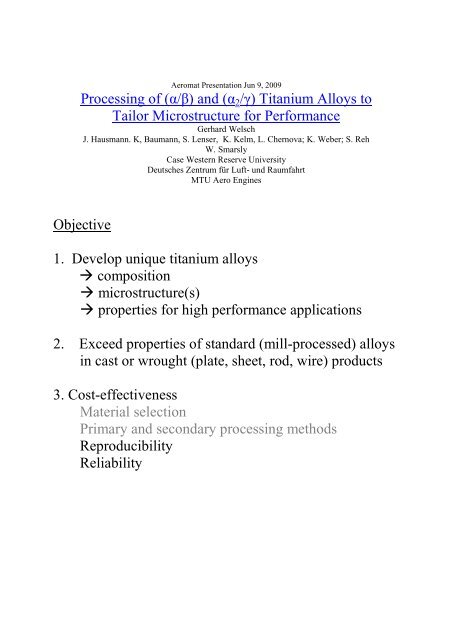


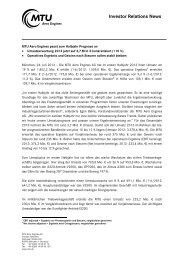
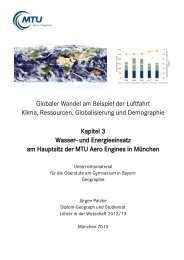
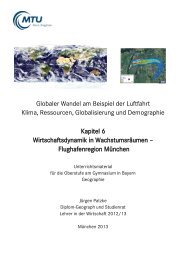
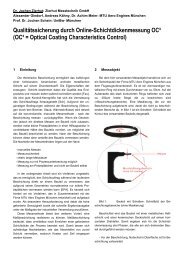
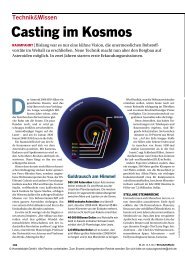

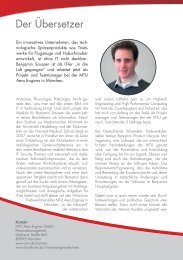
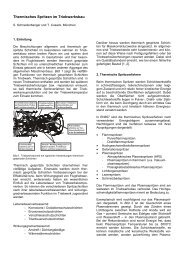
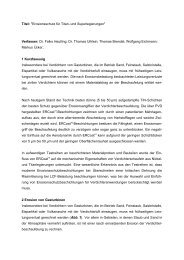


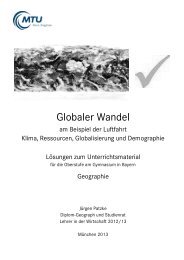
![Download PDF [5,37 MB] - MTU Aero Engines](https://img.yumpu.com/21945461/1/190x125/download-pdf-537-mb-mtu-aero-engines.jpg?quality=85)